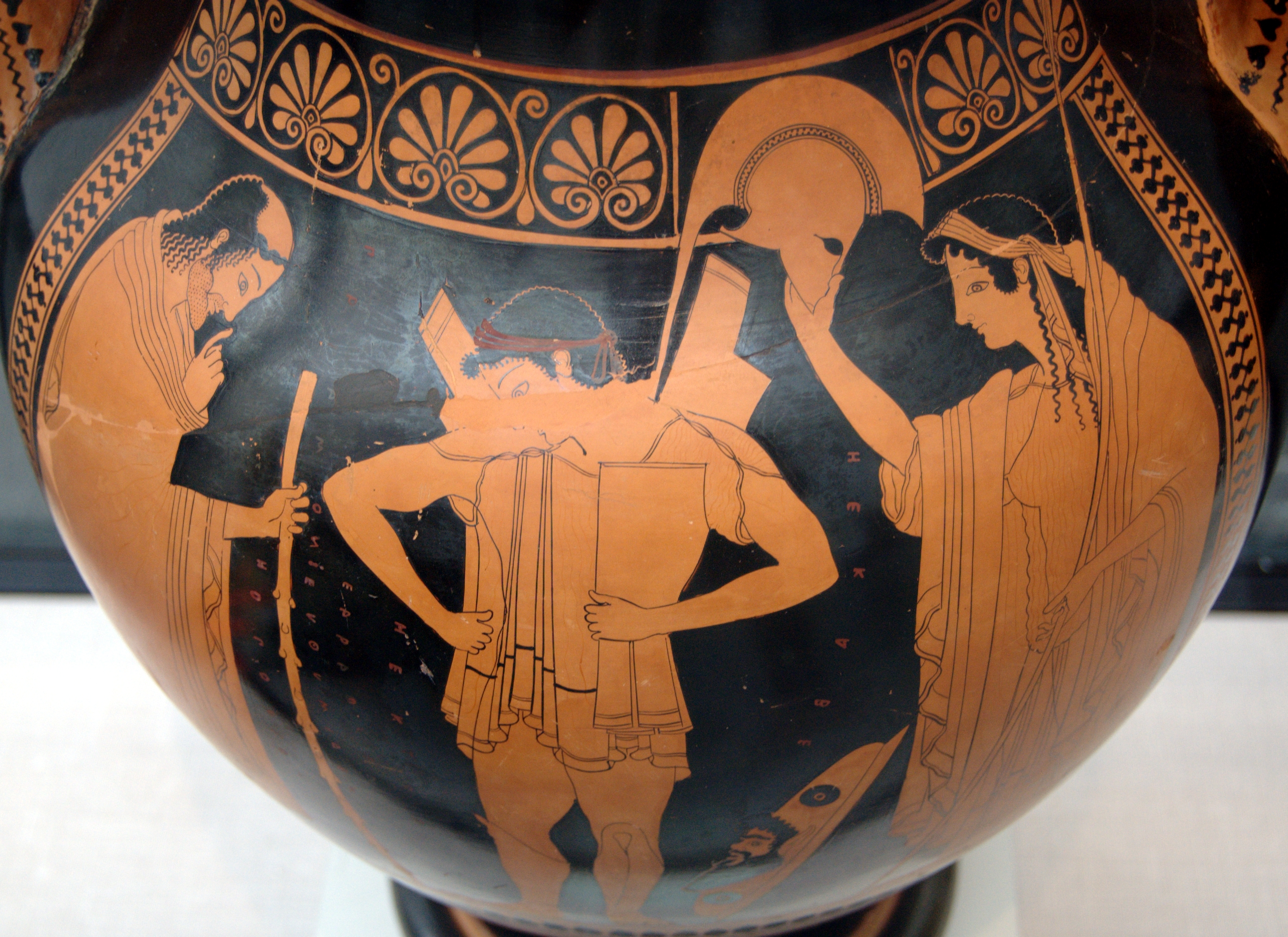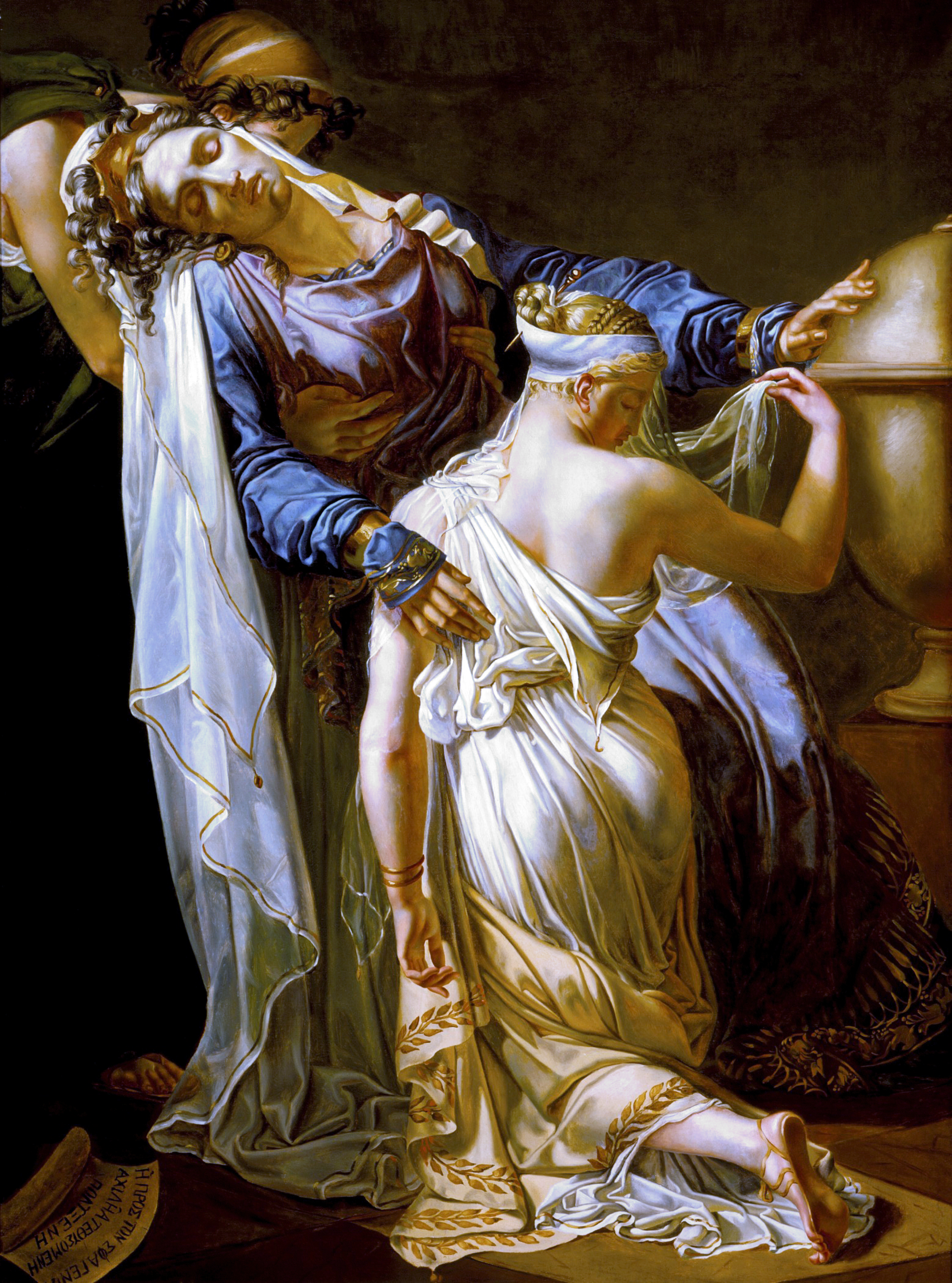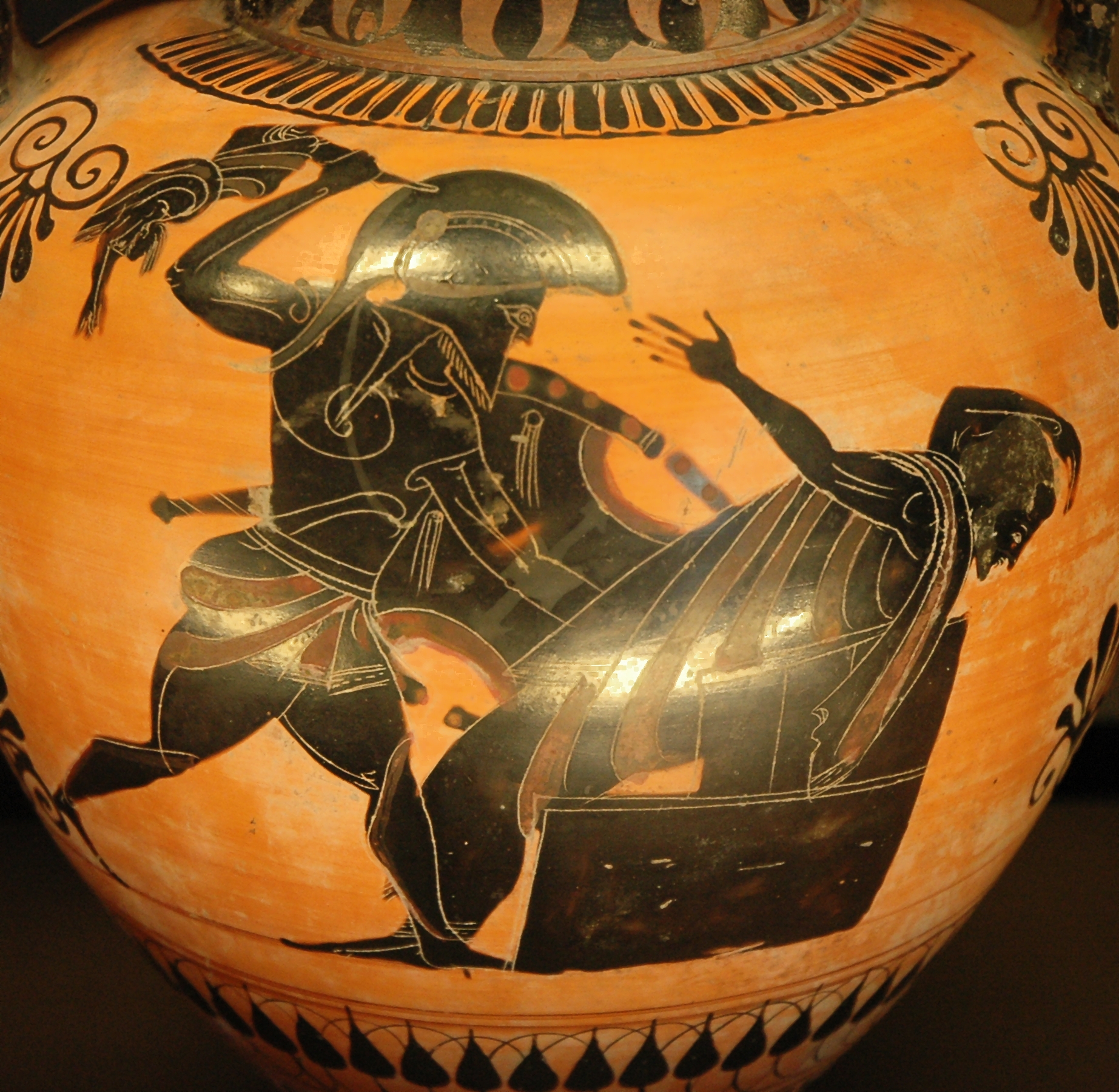|
The Revelers Vase
The Three Revelers Vase, also known as simply the Revelers Vase, is a Greek vase originating from the Archaic Period. Painted around 510 BCE in the red figure pottery style, the Revelers vase was found in an Etruscan tomb in Vulci, Italy. The painting is attributed to Euthymides. Although the vase is in the amphora shape, its purpose is more decorative than functional. The painting itself shows three nude partygoers and Hector arming on the reverse. The work is remarkable because of the early use of foreshortening (3/4 views) as opposed to conventional profile and frontal views. The Revelers Vase currently resides in the Staatliche Antikensammlungen in Münich, Germany. History The Revelers Vase, although of Greek origin, was discovered in an Etruscan tomb in Vulci, Italy. This discovery is evidence of the strong interaction between the Greek and Etruscan cultures. The earliest Greek colonies known in Italy date from around 800 BCE near the present day Bay of Naples. Since the 7th ... [...More Info...] [...Related Items...] OR: [Wikipedia] [Google] [Baidu] |
Hektor Arming Staatliche Antikensammlungen 2307
In Greek mythology, Hector (; grc, Ἕκτωρ, Hektōr, label=none, ) is a character in Homer's Iliad. He was a Trojan prince and the greatest warrior for Troy during the Trojan War. Hector led the Trojans and their allies in the defense of Troy, killing countless Greek warriors. He was ultimately killed in single combat by Achilles, who later dragged his dead body around the city of Troy behind his chariot. Etymology In Greek, is a derivative of the verb ἔχειν ''ékhein'', archaic form * grc, ἕχειν, hékhein, label=none ('to have' or 'to hold'), from Proto-Indo-European *'' seɡ́ʰ-'' ('to hold'). , or as found in Aeolic poetry, is also an epithet of Zeus in his capacity as 'he who holds verything together. Hector's name could thus be taken to mean 'holding fast'. Description Hector was described by the chronicler Malalas in his account of the ''Chronography'' as "dark-skinned, tall, very stoutly built, strong, good nose, wooly-haired, good beard, s ... [...More Info...] [...Related Items...] OR: [Wikipedia] [Google] [Baidu] |
Pioneer Group
The Pioneer Group is a term used by scholars for a number of vase painters working in potters' quarter of Kerameikos in ancient Athens around the beginning of the 5th century BC, around the time of the emergence of red-figure vase painting, which soon displaced the previously dominant black-figure style. Described by the British art historian John Boardman as perhaps the first conscious art movement in the western tradition, historians had included a number of artists in the group, including Epiktetos, Euphronios, Euthymides, Oltos, Phintias, Smikros, Hypsis, and the Dikaios Painter. Archaeologist John Beazley was the first to identify these artists as a coherent group in his works published in the 1940s, in which he developed a taxonomy of ancient Greek pottery by style. No documentary evidence remains of the artists, and everything we know about them was deduced from their surviving work. The Pioneer Group were not innovators of the red-figure technique but rather late adopt ... [...More Info...] [...Related Items...] OR: [Wikipedia] [Google] [Baidu] |
Archaeological Discoveries In Italy
Archaeology or archeology is the scientific study of human activity through the recovery and analysis of material culture. The archaeological record consists of artifacts, architecture, biofacts or ecofacts, sites, and cultural landscapes. Archaeology can be considered both a social science and a branch of the humanities. It is usually considered an independent academic discipline, but may also be classified as part of anthropology (in North America – the four-field approach), history or geography. Archaeologists study human prehistory and history, from the development of the first stone tools at Lomekwi in East Africa 3.3 million years ago up until recent decades. Archaeology is distinct from palaeontology, which is the study of fossil remains. Archaeology is particularly important for learning about prehistoric societies, for which, by definition, there are no written records. Prehistory includes over 99% of the human past, from the Paleolithic until the adve ... [...More Info...] [...Related Items...] OR: [Wikipedia] [Google] [Baidu] |
6th-century BC Works
The 6th century is the period from 501 through 600 in line with the Julian calendar. In the West, the century marks the end of Classical Antiquity and the beginning of the Middle Ages. The collapse of the Western Roman Empire late in the previous century left Europe fractured into many small Germanic kingdoms competing fiercely for land and wealth. From the upheaval the Franks rose to prominence and carved out a sizeable domain covering much of modern France and Germany. Meanwhile, the surviving Eastern Roman Empire began to expand under Emperor Justinian, who recaptured North Africa from the Vandals and attempted fully to recover Italy as well, in the hope of reinstating Roman control over the lands once ruled by the Western Roman Empire. In its second Golden Age, the Sassanid Empire reached the peak of its power under Khosrau I in the 6th century.Roberts, J: "History of the World.". Penguin, 1994. The classical Gupta Empire of Northern India, largely overrun by the Huna, ended in ... [...More Info...] [...Related Items...] OR: [Wikipedia] [Google] [Baidu] |
Thomson/Wadsworth
Cengage Group is an American educational content, technology, and services company for the higher education, K-12, professional, and library markets. It operates in more than 20 countries around the world.(Jun 27, 2014Global Publishing Leaders 2014: Cengage publishersweekly.comCompany Info - Wall Street JournalCengage LearningCompany Overview of Cengage Learning, Inc. BloombergBusiness Company information The company is headquartered in Boston, Massachusetts, and has approximately 5,000 employees worldwide across nearly 38 countries. It was headquartered at its Stamford, Connecticut, office until April 2014. |
Euphronios
Euphronios ( el, Εὐφρόνιος; c. 535 – after 470 BC) was an ancient Greek vase painter and potter, active in Athens in the late 6th and early 5th centuries BC. As part of the so-called "Pioneer Group," (a modern name given to a group of vase painters who were instrumental in effecting the change from black-figure to red-figure pottery), Euphronios was one of the most important artists of the red-figure technique. His works place him at the transition from Late Archaic to Early Classical art, and he is one of the first known artists in history to have signed his work. General considerations The discovery of Greek vase painters In contrast to other artists, such as sculptors, no Ancient Greek literature sources refer specifically to vase painters. The copious literary tradition on the arts hardly mention pottery. Thus, reconstruction of Euphronios's life and artistic development—like that of all Greek vase painters—can only be derived from his works. Modern s ... [...More Info...] [...Related Items...] OR: [Wikipedia] [Google] [Baidu] |
Hecuba
Hecuba (; also Hecabe; grc, Ἑκάβη, Hekábē, ) was a queen in Greek mythology, the wife of King Priam of Troy during the Trojan War. Description Hecuba was described by the chronicler Malalas in his account of the ''Chronography'' as "dark, good eyes, full grown, long nose, beautiful, generous, talkative, calm". Meanwhile, in the account of Dares the Phrygian, she was illustrated as ". . .beautiful, her figure large, her complexion dark. She thought like a man and was pious and just." Family Parentage Ancient sources vary as to the parentage of Hecuba. According to Homer, Hecuba was the daughter of King Dymas of Phrygia, but Euripides and Virgil write of her as the daughter of the Thracian king Cisseus. The mythographers Pseudo-Apollodorus and Hyginus leave open the question which of the two was her father, with Pseudo-Apollodorus adding a third alternative option: Hecuba's parents could as well be the river god Sangarius and Metope. Some versions from non-extant ... [...More Info...] [...Related Items...] OR: [Wikipedia] [Google] [Baidu] |
Priam
In Greek mythology, Priam (; grc-gre, Πρίαμος, ) was the legendary and last king of Troy during the Trojan War. He was the son of Laomedon. His many children included notable characters such as Hector, Paris, and Cassandra. Etymology Most scholars take the etymology of the name from the Luwian 𒉺𒊑𒀀𒈬𒀀 (Pa-ri-a-mu-a-, or “exceptionally courageous”), attested as the name of a man from Zazlippa, in Kizzuwatna. A similar form is attested transcribed in Greek as ''Paramoas'' near Kaisareia in Cappadocia. Some have identified Priam with the historical figure of Piyama-Radu, a warlord active in the vicinity of Wilusa. However, this identification is disputed, and is highly unlikely, given that he was known in Hittite records as being an ally of the Ahhiyawa against Wilusa. A popular folk etymology derives the name from the Greek verb , meaning 'to buy'. This in turn gives rise to a story of Priam's sister Hesione ransoming his freedom, with a golden veil that A ... [...More Info...] [...Related Items...] OR: [Wikipedia] [Google] [Baidu] |
Iliad
The ''Iliad'' (; grc, Ἰλιάς, Iliás, ; "a poem about Ilium") is one of two major ancient Greek epic poems attributed to Homer. It is one of the oldest extant works of literature still widely read by modern audiences. As with the ''Odyssey'', the poem is divided into 24 books and contains 15,693 lines in its most widely accepted version, and was written in dactylic hexameter. Set towards the end of the Trojan War, a ten-year siege of the city of Troy by a coalition of Mycenaean Greek states, the poem depicts significant events in the siege's final weeks. In particular, it depicts a fierce quarrel between King Agamemnon and a celebrated warrior, Achilles. It is a central part of the Epic Cycle. The ''Iliad'' is often regarded as the first substantial piece of European literature. The ''Iliad'', and the ''Odyssey'', were likely written down in Homeric Greek, a literary amalgam of Ionic Greek and other dialects, probably around the late 8th or early 7th century BC. Homer's ... [...More Info...] [...Related Items...] OR: [Wikipedia] [Google] [Baidu] |
Kantharos
A ''kantharos'' ( grc, κάνθαρος) or cantharus is a type of ancient Greek cup used for drinking. Although almost all surviving examples are in Greek pottery, the shape, like many Greek vessel types, probably originates in metalwork. In its iconic "Type A" form, it is characterized by its deep bowl, tall pedestal foot, and pair of high-swung handles which extend above the lip of the pot. The Greek words ''kotylos'' (κότῦλος, masculine) and ''kotyle'' (κοτύλη, feminine) are other ancient names for this same shape. The ''kantharos'' is a cup used to hold wine, possibly for drinking or for ritual use or offerings. The ''kantharos'' seems to be an attribute of Dionysos, the god of wine, who was associated with vegetation and fertility. As well as a banqueting cup, they could be used in pagan rituals as a symbol of rebirth or resurrection, the immortality offered by wine, "removing in moments of ecstasy the burden of self-consciousness and elevating man to t ... [...More Info...] [...Related Items...] OR: [Wikipedia] [Google] [Baidu] |
Bay Of Naples
A bay is a recessed, coastal body of water that directly connects to a larger main body of water, such as an ocean, a lake, or another bay. A large bay is usually called a gulf, sea, sound, or bight. A cove is a small, circular bay with a narrow entrance. A fjord is an elongated bay formed by glacial action. A bay can be the estuary of a river, such as the Chesapeake Bay, an estuary of the Susquehanna River. Bays may also be nested within each other; for example, James Bay is an arm of Hudson Bay in northeastern Canada. Some large bays, such as the Bay of Bengal and Hudson Bay, have varied marine geology. The land surrounding a bay often reduces the strength of winds and blocks waves. Bays may have as wide a variety of shoreline characteristics as other shorelines. In some cases, bays have beaches, which "are usually characterized by a steep upper foreshore with a broad, flat fronting terrace".Maurice Schwartz, ''Encyclopedia of Coastal Science'' (2006), p. 129. Bays were s ... [...More Info...] [...Related Items...] OR: [Wikipedia] [Google] [Baidu] |
Ancient Greek Art
Ancient Greek art stands out among that of other ancient cultures for its development of naturalistic but idealized depictions of the human body, in which largely nude male figures were generally the focus of innovation. The rate of stylistic development between about 750 and 300 BC was remarkable by ancient standards, and in surviving works is best seen in Ancient Greek sculpture, sculpture. There were important innovations in painting, which have to be essentially reconstructed due to the lack of original survivals of quality, other than the distinct field of painted pottery. Greek architecture, technically very simple, established a harmonious style with numerous detailed conventions that were largely adopted by Roman architecture and are still followed in some modern buildings. It used a vocabulary of ornament (art), ornament that was shared with pottery, metalwork and other media, and had an enormous influence on Eurasian art, especially after Buddhism carried it beyond the ... [...More Info...] [...Related Items...] OR: [Wikipedia] [Google] [Baidu] |


.jpg)




